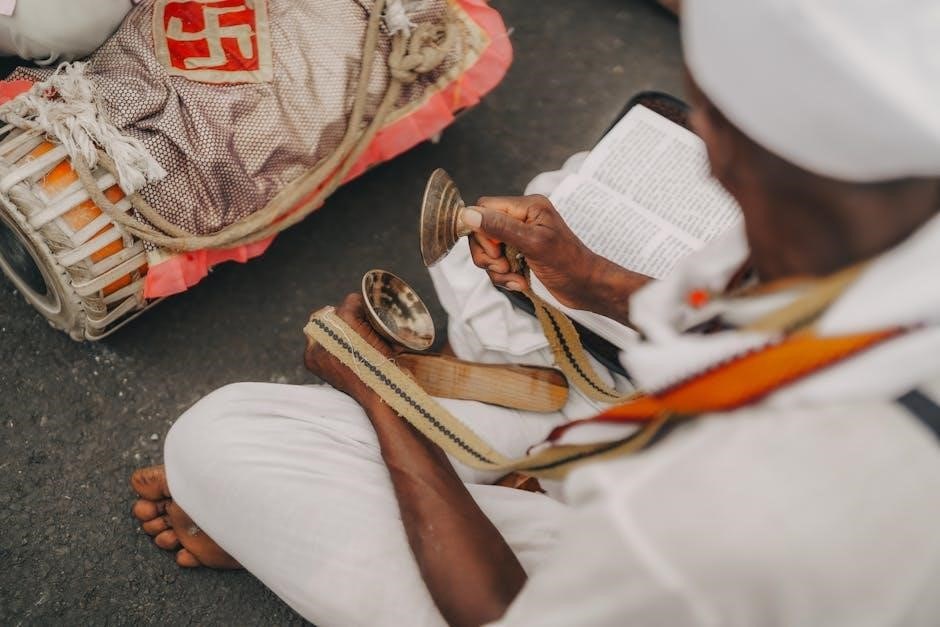The Book of Lilith, authored by Barbara Black Koltuv, explores the mythological figure of Lilith, tracing her origins in ancient texts and her cultural significance across traditions. First published in 1986, the book delves into Lilith’s role as a symbol of femininity, rebellion, and the repressed divine, offering insights into her enduring presence in mythology and modern spirituality.
Historical Background
Lilith’s origins trace back to ancient Sumerian literature, where she was known as “Dimme.” The Zohar, a 13th-century text, portrays her as Adam’s equal but rebellious. Her story symbolizes femininity and divine repression.
2.1. Sumerian Origins of Lilith
Lilith’s origins can be traced to ancient Sumerian literature, where she was referred to as “Dimme.” In Sumerian mythology, Lilith was often associated with the wind and darkness, embodying both the mysterious and the untamed. The Epic of Gilgamesh briefly mentions her, linking her to the divine and the natural world. Early Sumerian texts portray Lilith as a powerful, independent figure, often connected to the Lilitu, a group of female spirits associated with the wilderness and fertility. These depictions highlight her role as a symbol of the untamed feminine and the divine. Her association with the wind and night underscored her enigmatic nature, setting the groundwork for her later mythological evolution. The Sumerian understanding of Lilith laid the foundation for her complex characterization in subsequent cultures and texts, where she would become a figure of both fascination and controversy.
2.2. References in the Hebrew Bible
Lilith’s presence in the Hebrew Bible is subtle but significant. While she is not explicitly named, scholars often interpret references to the “night creature” or “winged beings” in texts like Isaiah 34:14 as allusions to Lilith. The Hebrew Bible’s depiction of her is shrouded in mystery, often linking her to the wilderness and chaos. These references suggest a figure associated with the unknown and the untamed, contrasting with the orderly creation narrative. The Hebrew Bible’s sparse but intriguing mentions of Lilith have led to extensive speculation and debate among scholars, contributing to her enigmatic status in Jewish tradition. Her association with the night and wilderness underscores her role as a symbol of the unknown and the divine feminine. These references, though brief, have had a lasting impact on Lilith’s characterization in later texts and traditions, solidifying her place in the cultural imagination.
2.3; Depiction in the Zohar
The Zohar, a foundational text of Jewish mysticism, provides a detailed and complex portrayal of Lilith. In this 13th-century Kabbalistic work, Lilith is described as a figure of immense power and duality, often associated with the divine feminine and the darker aspects of creation. The Zohar emphasizes her primordial existence, depicting her as a being created alongside Adam, with whom she shared equality but ultimately rebelled against. This text underscores her role as a symbol of rebellion and independence, refusing to submit to Adam’s authority. The Zohar also associates Lilith with the “harlot” and the “night,” linking her to the forces of chaos and the unseen. Her relationship with Samael, a fallen angel, is explored, as well as her role as the mother of demons. The Zohar’s depiction of Lilith highlights her dual nature, blending elements of seduction, power, and the divine, cementing her place as a central figure in Kabbalistic thought.

2.4. Evolution of Lilith’s Character
Lilith’s character has undergone significant evolution across various texts and cultures, reflecting shifting perspectives on femininity, power, and spirituality. In Sumerian mythology, she was first depicted as a goddess associated with fertility and chaos. The Hebrew Bible only briefly mentions her, but later rabbinic traditions expanded her role, often portraying her as a rebellious figure who refused to submit to Adam. The Zohar, a central Kabbalistic text, further elaborates on her divine and demonic aspects, linking her to the “Other Side” of creation. Over time, Lilith’s image transformed from a primordial deity to a symbol of female independence and empowerment. Modern interpretations, as explored in “The Book of Lilith,” emphasize her dual nature, blending elements of seduction, rebellion, and divine feminine energy. This evolution highlights her enduring relevance as a complex and multifaceted figure in mythology and spirituality.


Cultural and Religious Perspectives
Lilith’s figure crosses cultural boundaries, appearing in Mesopotamian mythology as a goddess and in Jewish texts as Adam’s first wife. Her depictions vary widely, from a demonic entity to a symbol of female empowerment, reflecting diverse religious and cultural interpretations over time.
3.1. Mesopotamian Mythology
In Mesopotamian mythology, Lilith is often associated with the Sumerian goddess Dimme, known for her association with wind and the natural world. The Epic of Gilgamesh briefly mentions a figure resembling Lilith, linking her to the wild and chaotic forces of nature. In these ancient texts, Lilith is portrayed as a powerful, independent entity, sometimes depicted as a winged creature. Her role in Mesopotamian myths often symbolizes the untamed aspects of femininity and the divine. This early depiction of Lilith as a goddess with her own autonomy laid the groundwork for her later interpretations in various religious traditions. The Book of Lilith explores how these ancient myths influenced her evolution in Jewish and Christian texts, highlighting her enduring significance as a symbol of both danger and empowerment.
3.2. Christian Interpretations
Christian interpretations of Lilith often portray her as a figure of darkness and temptation, contrasting with the purity of Eve. Early Christian texts draw from Jewish traditions, emphasizing Lilith’s rebellious nature and her role as Adam’s first wife who refused submission. Some apocryphal writings depict Lilith as a fallen angel or a demon, associating her with sin and corruption. The Book of Lilith examines how Christian theology reinforced her image as a symbol of evil, often linking her to the serpent in the Garden of Eden. Despite this, some modern Christian feminist perspectives reinterpret Lilith as a symbol of resistance against patriarchal structures, highlighting her refusal to be subjugated. This duality in Christian views underscores Lilith’s complex role in religious symbolism, reflecting both fear of female power and admiration for her defiance.
3.3. Modern Interpretations
In modern times, Lilith has evolved into a symbol of female empowerment and independence, resonating with feminist movements. The Book of Lilith highlights her transformation from a biblical outcast to a figure of liberation, embodying resistance against patriarchal norms. Contemporary interpretations often depict her as a powerful archetype, representing autonomy and self-determination. Spiritual practices and modern witchcraft frequently invoke Lilith as a protector of women’s rights and a challenger of oppressive systems. Her image also appears in literature, art, and popular culture, where she is portrayed as both a seductress and a guardian of divine feminine energy. This shift reflects a broader societal reevaluation of femininity and power, with Lilith becoming a central figure in discussions about gender equality and personal sovereignty. Her enduring appeal lies in her ability to embody both rebellion and resilience, making her a compelling symbol in modern discourse.
3.4. Lilith in Folklore
Lilith’s presence in folklore is marked by her enigmatic and often fearsome depiction. In various traditions, she is portrayed as a night demon, associated with darkness, childbirth, and the supernatural. Folkloric tales frequently describe her as a seductress and a threat to infants, emphasizing her role as a malevolent entity. However, some narratives also highlight her connection to fertility and the protection of women, creating a duality in her character. Lilith’s refusal to submit to Adam in Eden has become a central theme in folklore, symbolizing her defiance and independence. This aspect has led to her being seen as both a figure of fear and a symbol of liberation. Modern interpretations of folklore often blend these elements, presenting Lilith as a complex figure who embodies both danger and empowerment. Her enduring presence in folklore underscores her significance as a cultural and symbolic archetype, continuing to captivate audiences across generations.
Literary Works
Literary works featuring Lilith explore her mythological significance, delving into themes of rebellion, femininity, and power. Notable authors, including Barbara Black Koltuv, offer profound insights into her character and cultural impact through their writings.
4.1. “The Book of Lilith” by Barbara Black Koltuv
Barbara Black Koltuv’s The Book of Lilith, first published in 1986, is a seminal work exploring the mythological figure of Lilith across various cultures and texts. The book delves into the origins of Lilith, tracing her evolution from ancient Sumerian mythology to her depiction in the Zohar and other religious texts. Koltuv examines Lilith’s symbolic role as a representation of the repressed feminine and her defiance against patriarchal structures. The text also explores Lilith’s dual nature, portraying her as both a seductress and a symbol of empowerment. By analyzing historical and mythological sources, Koltuv offers a comprehensive understanding of Lilith’s significance, challenging traditional interpretations and highlighting her enduring relevance in modern spirituality. This work has become a cornerstone for those interested in feminist theology and the study of mythological archetypes.
4.2. Other Notable Literary Works

Beyond Barbara Black Koltuv’s The Book of Lilith, numerous literary works have explored the enigmatic figure of Lilith. In modern literature, authors like Michelle Scott and Esra Pekin have contributed to the discourse, offering fresh perspectives on her mythos. Scott’s Straight to Hell and Pekin’s Lilith delve into her dual nature, blending historical narratives with contemporary themes. These works often portray Lilith as a complex character, embodying both rebellion and empowerment. Additionally, literary adaptations in various genres, from thriller to fantasy, have further cemented Lilith’s place in modern storytelling. These narratives not only reinterpret her ancient origins but also highlight her relevance in today’s cultural landscape, ensuring her enduring presence in literature. By exploring diverse interpretations, these works collectively enrich the understanding of Lilith’s multifaceted identity and her timeless appeal.
4.3. Contemporary Literature Featuring Lilith
Contemporary literature has embraced Lilith as a compelling figure, weaving her myth into various genres. In works like Brutal Intentions by Lilith Vincent, her character is reimagined within thrilling narratives, captivating readers with intricate plots and psychological depth. Similarly, authors like Krysten Ritter and Annie Rains incorporate elements of Lilith’s legend into their stories, blending folklore with modern storytelling. These adaptations often highlight her dual nature—both seductress and protector—offering fresh insights into her archetypal significance. The integration of Lilith into contemporary fiction not only reflects her enduring allure but also demonstrates her relevance in exploring themes of identity, power, and femininity. Through these works, Lilith continues to evolve, becoming a symbol of resilience and empowerment in modern literature.
4.4. Comparative Analysis of Literary Depictions
A comparative analysis of literary depictions of Lilith reveals a diverse interpretation of her character across texts. In The Book of Lilith by Barbara Black Koltuv, Lilith is portrayed as a symbol of repressed femininity and divine rebellion, while in other works like Straight to Hell by Michelle Scott, she is depicted as a complex figure with both seductive and protective qualities. Contemporary authors like Esra Pekin and Lilith Vincent reimagine her as a multifaceted entity, blending ancient myths with modern themes of empowerment. Some texts emphasize her role as a mother of demons, while others focus on her as a feminist icon. This variation highlights Lilith’s adaptability as a literary figure, reflecting changing societal views on femininity, power, and spirituality. The evolution of her character underscores her enduring relevance in literature, allowing readers to connect with her on multiple levels. This comparative approach enriches our understanding of Lilith’s cultural and symbolic significance.
4.5. Influence of Lilith on Modern Writing
Lilith’s enigmatic presence has profoundly influenced modern writing, inspiring authors to explore her complex identity and symbolism. Works like The Book of Lilith by Barbara Black Koltuv have sparked a wave of literary reinterpretations, blending ancient myths with contemporary themes. Modern writers often depict Lilith as a symbol of feminism and empowerment, challenging traditional narratives. For instance, Michelle Scott’s Straight to Hell reimagines Lilith as a multifaceted character, blending seduction with strength. Similarly, authors like Esra Pekin and Lilith Vincent incorporate her story into thrillers and fantasy, showcasing her adaptability across genres. The character’s duality—both divine and rebellious—resonates with readers, making her a compelling figure in modern literature. This influence extends beyond fiction, with Lilith appearing in spiritual and philosophical texts as a metaphor for self-discovery and liberation. Her enduring appeal lies in her ability to embody both the shadow and the light, offering writers rich material for exploration. As a result, Lilith continues to inspire new generations of authors, ensuring her legacy in modern writing.

Themes and Symbolism
Lilith symbolizes femininity, rebellion, and the divine, embodying the duality of light and shadow, reflecting themes of empowerment and self-discovery in modern contexts.

5.1. Feminism and Female Empowerment

Lilith, as depicted in The Book of Lilith, emerges as a powerful symbol of feminism and female empowerment. Her refusal to submit to patriarchal norms, exemplified by her defiance of Adam, resonates deeply with modern feminist ideals. The book explores how Lilith’s story challenges traditional gender roles, positioning her as a figure of autonomy and self-determination. By reclaiming Lilith’s narrative, the text underscores themes of equality, independence, and the rejection of oppressive systems. Lilith’s character embodies the struggle for women’s rights, making her a compelling archetype for contemporary feminist discourse. The book also highlights how Lilith’s exile and resilience serve as metaphors for the marginalization of women throughout history, offering a profound critique of societal structures. Through her story, The Book of Lilith invites readers to reflect on the enduring relevance of female empowerment and the importance of reclaiming suppressed narratives.
5.2. The Duality of Lilith
Lilith, as explored in The Book of Lilith, embodies a profound duality, representing both light and darkness, creation and destruction. Her character oscillates between benevolent protector and malevolent force, reflecting the complexities of human nature. On one hand, she is depicted as a guardian of women and children, advocating for their rights and empowerment. On the other, she is often portrayed as a seductress and destroyer, symbolizing the untamed aspects of femininity. This duality highlights her multifaceted role in mythology, where she transcends simplistic categorization. The book delves into how Lilith’s dual nature challenges binary thinking, offering a nuanced exploration of her identity. By examining both her nurturing and destructive qualities, The Book of Lilith provides a balanced perspective on her enigmatic figure, inviting readers to embrace the richness of her contradictions. This duality makes Lilith a compelling and thought-provoking archetype, resonating with themes of balance and the interplay of opposing forces in human experience.
5.3. Psychological and Archetypal Insights
The Book of Lilith offers profound psychological and archetypal insights into the figure of Lilith, exploring her role as a symbol of the repressed feminine and the shadow aspects of human consciousness. Drawing on Jungian concepts, the book portrays Lilith as the embodiment of the anima, representing the unconscious, intuitive, and nurturing qualities often suppressed in patriarchal societies. Her defiance and independence symbolize the struggle for self-discovery and the integration of opposites, making her a powerful archetype for personal growth. The text also delves into Lilith’s connection to the collective unconscious, where she represents the untamed, instinctual aspects of humanity. By examining her myth, the book provides a deeper understanding of the psychological duality within individuals, emphasizing the importance of acknowledging and embracing the shadow self. This archetypal analysis invites readers to reflect on Lilith’s relevance in modern psychology and spirituality, offering a bridge between ancient mythology and contemporary self-awareness.
5.4. Symbolism in Modern Contexts
Lilith’s symbolism in modern contexts extends beyond ancient mythology, representing themes of empowerment, rebellion, and the divine feminine. In contemporary culture, she embodies resistance against patriarchal norms, symbolizing independence and self-determination. Her image has been appropriated in feminist discourse as a metaphor for female autonomy and the rejection of oppressive structures. Additionally, Lilith’s association with the shadow self resonates in psychological interpretations, where she represents the unconscious, untamed aspects of the psyche. In spiritual practices, she is often invoked as a symbol of transformation and inner strength, encouraging individuals to embrace their darker, more hidden qualities. Her modern symbolism also intersects with themes of resilience and self-discovery, making her a powerful figure in both personal and collective journeys. This versatility ensures Lilith’s enduring relevance, bridging ancient myths with contemporary ideologies and spiritual practices.

Practical Applications
The Book of Lilith inspires practical applications like rituals, meditations, and invocations, helping individuals connect with themes of empowerment, self-discovery, and the divine feminine. These practices foster personal growth and spiritual transformation.
6.1. Rituals and Practices
Lilith-inspired rituals and practices often focus on themes of empowerment, self-discovery, and reclaiming the divine feminine. These practices, as explored in The Book of Lilith, encourage individuals to embrace their inner strength and autonomy. Rituals may involve invocations of Lilith as a symbol of liberation, often performed during specific lunar phases or moments of personal transformation. Meditation and reflection on Lilith’s mythos can help practitioners confront societal expectations and embody their true selves. Some rituals incorporate elements like candles, mirrors, or sacred symbols to connect with Lilith’s essence. These practices aim to foster resilience, self-awareness, and a deeper understanding of femininity’s power. By engaging with Lilith’s story, individuals can reclaim their agency and explore the duality of human nature. Such rituals are particularly meaningful for those seeking to align with Lilith’s archetype of independence and defiance.
6.2; Prayers and Invocations

Prayers and invocations dedicated to Lilith often seek to honor her as a symbol of empowerment and liberation. These spiritual practices, as discussed in The Book of Lilith, aim to connect individuals with her essence, emphasizing themes of self-discovery and resilience. Many prayers invoke Lilith as a guardian of feminine power, asking for guidance in reclaiming autonomy and challenging societal norms. Some rituals involve reciting specific hymns or chants, while others focus on meditative reflection. The prayers often emphasize Lilith’s role as a protector of women and a defender against injustice. These invocations are deeply personal, allowing practitioners to channel Lilith’s energy for healing, strength, and transformation. By engaging with these prayers, individuals can explore the duality of Lilith’s nature and find inspiration in her unyielding spirit. Such practices are particularly meaningful for those seeking to embody Lilith’s qualities of courage and independence.
6.3. Modern Spiritual Practices
Modern spiritual practices involving Lilith emphasize personal empowerment, self-reflection, and connection with the divine feminine. Inspired by The Book of Lilith, many contemporary rituals focus on reclaiming Lilith’s story as a symbol of liberation. Practices often include meditation, journaling, and creating sacred spaces to honor her presence. Some individuals incorporate elements of shadow work, exploring aspects of themselves they may have suppressed. Rituals may involve the use of candles, specific gemstones, or sacred symbols associated with Lilith, such as the moon or serpent imagery. These practices aim to embody Lilith’s qualities of resilience and independence, fostering a deeper understanding of her role in modern spirituality. By engaging with these rituals, practitioners seek to integrate Lilith’s essence into their lives, promoting healing, growth, and a balanced connection to both the divine and the self.
6.4. Integrating Lilith into Contemporary Spirituality
Lilith’s integration into contemporary spirituality reflects her enduring relevance as a symbol of empowerment and self-discovery. Drawing from The Book of Lilith, modern practitioners often incorporate her story into rituals, meditations, and personal reflection. Many embrace Lilith as a representation of feminine power, resilience, and autonomy, resonating with feminist and individualistic values. Rituals may involve honoring her connection to the moon, serpents, and the night, symbolizing transformation and intuition. Some practices focus on shadow work, encouraging individuals to confront repressed aspects of themselves, aligning with Lilith’s role as a figure who defies conformity. By integrating Lilith into their spiritual journeys, people seek to embody her courage and independence, fostering a deeper connection to their own inner strength. This modern reverence for Lilith highlights her adaptability as a spiritual icon, bridging ancient mythology with contemporary seekers of meaning and empowerment.
The exploration of Lilith through The Book of Lilith reveals her profound impact on mythology, spirituality, and cultural narratives. As a figure of rebellion and empowerment, Lilith challenges traditional norms, embodying both darkness and light. Her story, rooted in ancient texts like the Zohar, has evolved over centuries, resonating with modern seekers of meaning. The book highlights Lilith’s symbolism of the repressed feminine and her role as a catalyst for self-discovery. By examining her mythos, readers gain insight into themes of autonomy, shadow work, and the divine feminine. Lilith’s enduring presence in literature and spirituality underscores her relevance in contemporary discourse, offering a powerful archetype for personal and collective transformation. This concludes the journey through Lilith’s complex legacy, inviting readers to reflect on her timeless significance in shaping cultural and spiritual consciousness.
